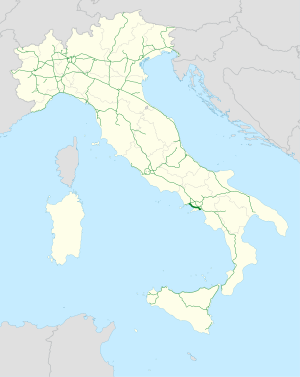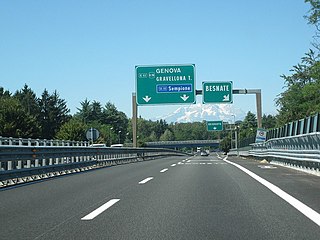
Italy has a well developed transport infrastructure. The Italian rail network is extensive, especially in the north, and it includes a high-speed rail network that joins the major cities of Italy from Naples through northern cities such as Milan and Turin. The Florence–Rome high-speed railway was the first high-speed line opened in Europe when more than half of it opened in 1977. Italy has 2,507 people and 12.46 km2 per kilometer of rail track, giving Italy the world's 13th largest rail network. The Italian rail network is operated by state-owned Ferrovie dello Stato, while the rail tracks and infrastructure are managed by Rete Ferroviaria Italiana.

The Strait of Messina Bridge is a planned 3.6-kilometre suspension bridge across the Strait of Messina, connecting Torre Faro in Sicily with Villa San Giovanni in the Italian Peninsula.
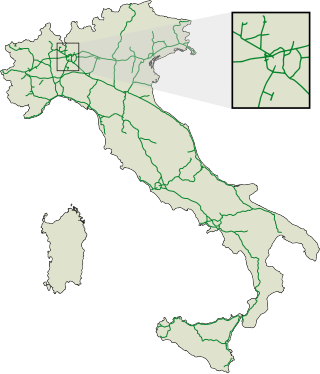
The autostrade are roads forming the Italian national system of motorways. The total length of the system is about 7,016 kilometres (4,360 mi), as of 30 July 2022. To these data are added 13 motorway spur routes, which extend for 355 kilometres (221 mi).
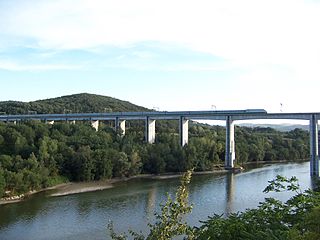
High-speed rail in Italy consists of two lines connecting most of the country's major cities. The first line connects Turin to Salerno via Milan, Bologna, Florence, Rome and Naples, the second runs from Turin to Venice via Milan and Verona, and is under construction in parts. Trains are operated with a top speed of 300 km/h (190 mph).

The Autostrada A1, nicknamed Autostrada del Sole, is the longest autostrada in Italy, linking some of the largest cities of the country: Milan, Bologna, Florence, Rome and Naples. It is a part of the E35 and E45 European routes.

The Autostrada A26 is a motorway in the northwestern Italian regions of Liguria and Piedmont. It is named the Autostrada dei Trafori after the numerous tunnels through which it passes, both Apennine and Subalpine. It runs northwards from Genoa on the Ligurian coast, over the Apennines, and across the wide plain of the Po valley to the environs of Lake Maggiore and the mouth of the Val d’Ossola. In addition to this ‘main trunk’ of the road, there are three side branches, also of motorway class which function as link roads between the A26 and the A7, the A4 and the A8. The A26, together with these link roads, is managed by Autostrade per l'Italia S.p.A.

Autostrada A2, otherwise known as the Autostrada del Mediterraneo or Salerno–Reggio Calabria, is an autostrada long 432 kilometres (268 mi) in the south of Italy. Running between the towns of Fisciano, in the Province of Salerno, and Villa San Giovanni, in the Province of Reggio Calabria, the motorway forms part of European roads E45, E841 and E90.

The Autostrada A4, or Autostrada Serenissima, is an autostrada which connects Turin and Trieste via Milan and Venice. The city of Venice originally formed a bottleneck on the A4, but is now bypassed by the Passante di Mestre. The A4 passes just north of the city of Milan, where it is toll-free.

The Autostrada A91, also called Autostrada Roma-Fiumicino, is an Italian motorway which connects Rome to the Fiumicino Airport.

Adriatic–Ionian motorway or Trieste-Kalamata Highway or the Blue Corridor, is a future motorway that will stretch along the entire eastern shore of the Adriatic and Ionian seas, spanning the western coast of the Balkan peninsula from Italy in the north through Slovenia, Croatia, Montenegro, Albania to Greece in the south.
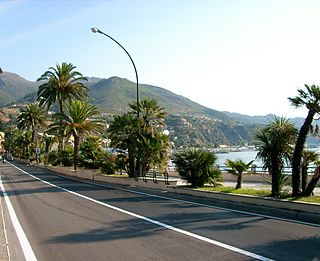
The Strade Statali, abbreviated SS, is the Italian national network of state highways. The total length for the network is about 25,000 km (16,000 mi).

The A3 motorway is a motorway in Albania spanning 31.17 kilometres across the counties of Elbasan and Tirana. It consists of two traffic lanes and an emergency lane in each driving direction, except in tunnels where there are emergency bays instead, separated by a central reservation.

Roads in Italy are an important mode of transport in Italy. The classification of the roads of Italy is regulated by the Italian traffic code, both from a technical and administrative point of view. The street nomenclature largely reflects the administrative classification. Italy is one of the countries with the most vehicles per capita, with 690 per 1000 people in 2010.

The Autostrada A30 is an Italian motorway which connects Caserta to Salerno.

The Salerno–Reggio Calabria railway is the most important north–south railway connection between Sicily, Calabria and the rest of the Italian peninsula. It forms the southern section of Corridor 1 of the European Union's Trans-European high-speed rail network, which connects Berlin and Palermo. Its southern part, between Rosarno and San Lucido is also used as an RFI freight route between the Port of Gioia Tauro and the Adriatic railway.

The strada statale 18 "Tirrena Inferiore" is an Italian state road, connecting Campania and Calabria. It is among the longest and most important state highways in southern Italy, considering that it follows the Tyrrhenian coast, from Salerno to Reggio di Calabria.

Raccordo autostradale RA4 is a motorway that connects the Autostrada A2 with Strada statale 106 Jonica through the city of Reggio Calabria. The motorway junction also constitutes the central section of the so-called Reggio Calabria ring road.

Raccordo autostradale 6 , managed by ANAS, is a motorway in Central Italy and allows a quick connection of the SS 3 bis near the city of Perugia with the Autostrada del Sole where the route begins in the locality of Bettolle, municipality of Sinalunga (SI). The RA 6 is a seamless continuation of the Strada statale 715 Siena-Bettolle and, on the other end, it continues as SS 75 up to Foligno.
